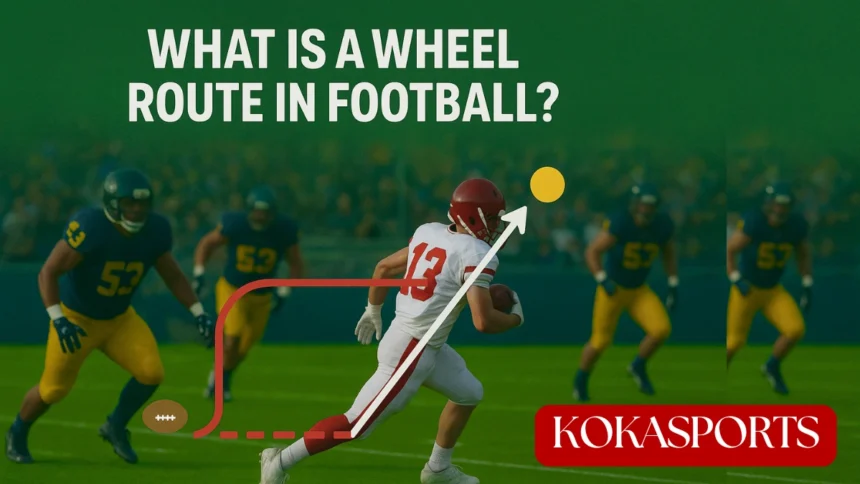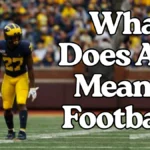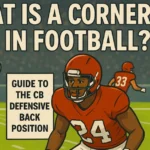The wheel route stands as one of football’s most versatile and game-changing pass concepts, capable of transforming a simple checkdown into an explosive touchdown. Whether you’re studying NFL strategies, building your playbook, or just want to understand what commentators mean when they mention this route, this comprehensive guide will break down everything you need to know about the wheel route in simple terms.
From youth football football coaches teaching basic concepts to professional coordinators designing complex systems, the wheel route remains a cornerstone of modern offense. This route challenges defenders at every level and creates mismatches that even the best coverage schemes struggle to handle.
What is a Wheel Route in Football-NFL Playbook vs Flat Route Guide

Wheel Route Basics in the NFL Playbook
The wheel route is a receiver pattern that starts with a short horizontal movement before curving upfield along the sideline. Think of it like drawing a quarter-circle or wheel shape on the field – hence the name “wheel route.” This route differs significantly from a simple flat route, which stays horizontal, or a go route, which goes straight down the field.
In any modern playbook, the wheel route serves multiple purposes. It can act as a safety valve for the quarterback when primary receivers are covered, or it can become the main target when the defense shows specific coverage. The route typically begins with the receiver taking five yards or less toward the sideline before making a sharp turn upfield.
Key characteristics of a wheel route include:
- Initial movement: 3-5 yards toward the sideline
- Sharp turn: Quick pivot upfield at approximately 5 yards depth
- Acceleration phase: Full sprint along the sideline after the turn
- Hand positioning: Ready to catch throughout the entire route
- Eyes: Always looking back toward the quarterback after the turn
The beauty of the wheel route lies in its deception. Defenders often expect a route to the flat or a short hitch, making the sudden turn upfield particularly effective. This route works exceptionally well in flag football plays where defenders have limited ability to make physical contact, allowing receivers more freedom to execute the pattern.
Wheel Route Design: Flag Football to NFL Post Route Concepts
Modern wheel route design goes far beyond simply having a receiver run toward the sideline and turn upfield. Today’s coordinators integrate wheel routes into complex route combinations that create multiple problems for defenders simultaneously. The route serves as both a primary option and a safety valve, giving quarterbacks flexibility in their decision-making process.
NFL teams typically design wheel route concepts around specific personnel packages and formation strengths. When a running back aligns in the backfield, the wheel route can catch linebackers off-guard who expect a flat route or screen pass. Similarly, when a slot receiver runs the wheel, it can create favorable matchups against safeties who are responsible for deeper coverage.
Strategic wheel route applications:
| Situation | Primary Benefit | Key Matchup | Success Rate |
|---|---|---|---|
| Red zone | Compressed coverage | RB vs linebacker | High |
| Third down | Unexpected route choice | Receiver vs zone coverage | Medium-High |
| Blitz situation | Open space creation | Wheel runner vs vacated area | Very High |
| Cover 2 defense | Safety depth | Receiver vs underneath coverage | High |
The double wheel concept deserves special attention because it creates an overload situation for coverage. When two receivers run wheel routes on the same side of the field, defenders must choose which receiver to prioritize, often resulting in one finding significant open space.
Read More: The Tallest NFL Player of 2025
Running the Wheel Route: Hitch and Shallow Cross Techniques
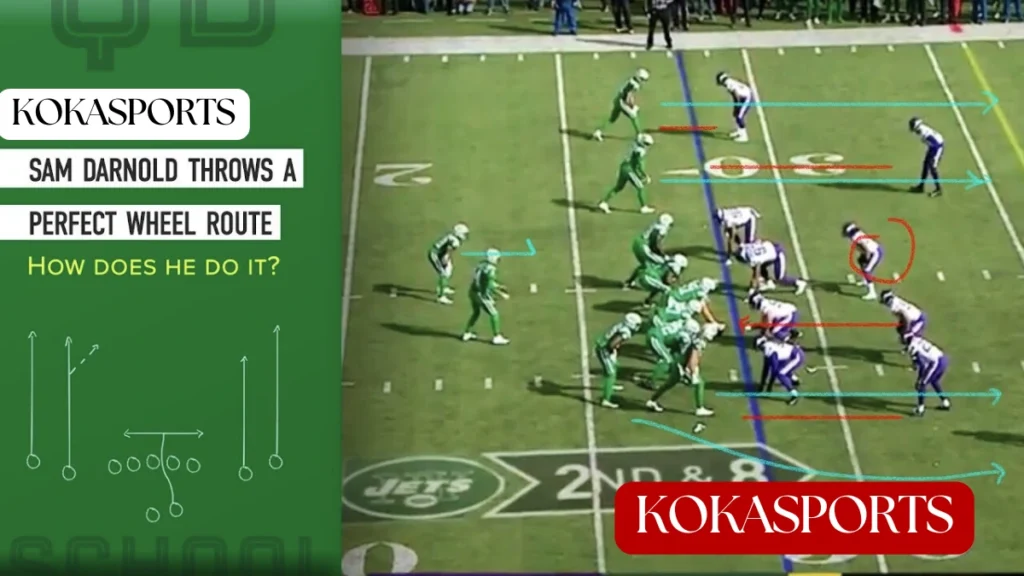
Running the Wheel Route: Step-by-Step Breakdown
Proper wheel route execution requires mastering several technical elements that work together to create separation from defenders. The route’s effectiveness depends on selling the initial flat movement before making the critical upfield turn that catches coverage off-guard.
Running the wheel involves a precise sequence that must look like a flat route initially. The receiver starts near the line of scrimmage with a free release to avoid any defender jam while quickly establishing horizontal movement. This release should mirror the technique used for a standard flat route to maintain deception throughout the early phase.
Critical wheel route technique points:
- Release: Clean start from line of scrimmage avoiding defender contact
- Flat phase: Run parallel to line of scrimmage for 3-5 yards
- Turn: Receiver turns sharply upfield using outside foot plant
- Acceleration: Explosive burst after turn to create maximum separation
- Ball tracking: Maintain visual contact with quarterback throughout route
The turn portion represents the most crucial technical aspect. The receiver must plant firmly and drive off to change direction upfield. Any hesitation allows defenders to close distance and disrupt the route’s timing. After completing the turn, the receiver must immediately accelerate to top speed while staying aware of sideline boundaries.
Position-Specific Wheel Route Techniques
Different positions require slightly modified approaches to wheel route execution based on their alignment and role within the offense. A running back executing a wheel route from the backfield faces different challenges than a wide receiver running the same route from a split position.
Running back wheel route execution often begins with a check-release action where the rb initially looks for blitz pickup responsibilities before releasing on the route. This delayed release can actually benefit the route because it gives linebackers more time to commit to other coverage responsibilities or bite on play-action fakes.
The rb‘s alignment in the backfield provides natural deception for the wheel route. Defenders expect running backs to stay near the line of scrimmage for check-down passes. When the back runs suddenly upfield on the wheel, it often catches coverage completely off-guard, especially slower defenders like linebackers.
Position-specific considerations:
- Running Back: Check-release timing, linebacker mismatch focus
- Wide Receiver: Clean release technique, precise timing with qb
- Tight End: Chip block option before release, seam-to-wheel conversion
- Outside Receiver: Sideline awareness, safety coverage stress
Flag football modifications focus on avoiding defenders through technique rather than physical contact. Players must rely more heavily on footwork, change of pace, and route precision since physical blocking is limited.
Have NFL Teams Broken the Wheel Route? Flag Football Slant Innovations

Evolution of Wheel Routes in the Modern NFL
The wheel route has undergone significant evolution since its introduction to professional football. Modern NFL offenses have transformed this basic concept into a sophisticated weapon that can attack coverage in ways that traditional wheel routes never could. Today’s implementations feature multiple variations, timing adjustments, and strategic applications.
Analytics have played a crucial role in the wheel route‘s modern evolution. NFL teams now understand exactly which coverage types and down-and-distance situations provide the highest success rates for wheel concepts. This data-driven approach has led to more strategic usage rather than random deployment of the route.
Modern wheel route innovations include:
- Motion-based wheels: Using pre-snap motion to create advantageous alignments
- RPO integration: Quarterback reads determining wheel vs. run options
- Tempo changes: Varying route speed to disrupt defender’s momentum
- Formation shifts: Late alignment changes to disguise wheel intentions
- Multiple receiver wheels: Double wheel concepts creating coverage overload
The integration of wheel route concepts with modern spread formations has created new opportunities for offense coordinators. Receivers can now run wheel routes from multiple positions simultaneously, creating overload situations that strain even sophisticated coverage schemes.
Advanced Wheel Route Concepts
Today’s wheel route concepts go far beyond basic receiver patterns. Modern coordinators design wheel routes as part of integrated systems that attack multiple coverage levels simultaneously. These advanced concepts make it nearly impossible for defenders to provide adequate help while maintaining their other responsibilities.
Advanced wheel route combinations:
| Concept | Formation | Primary Stress | Coverage Challenge |
|---|---|---|---|
| Smash-Wheel | Trips | High-low stretch | Safety coverage decision |
| Flood-Wheel | Bunch | Horizontal overload | Zone coverage gaps |
| Shallow cross-Wheel | Spread | Pick/rub action | Man coverage confusion |
| Post route-Wheel | 2×2 | Vertical stretch | Middle of the field vs sideline |
The smash-wheel combination creates a particularly difficult situation for coverage. The concept features a receiver running a speed out route while another runs the wheel route behind it. This high-low concept forces the coverage defender to choose between defending the short route or the wheel route.
Route Tree: Wheel Routes, Post Routes & Go Routes in NFL Playbooks
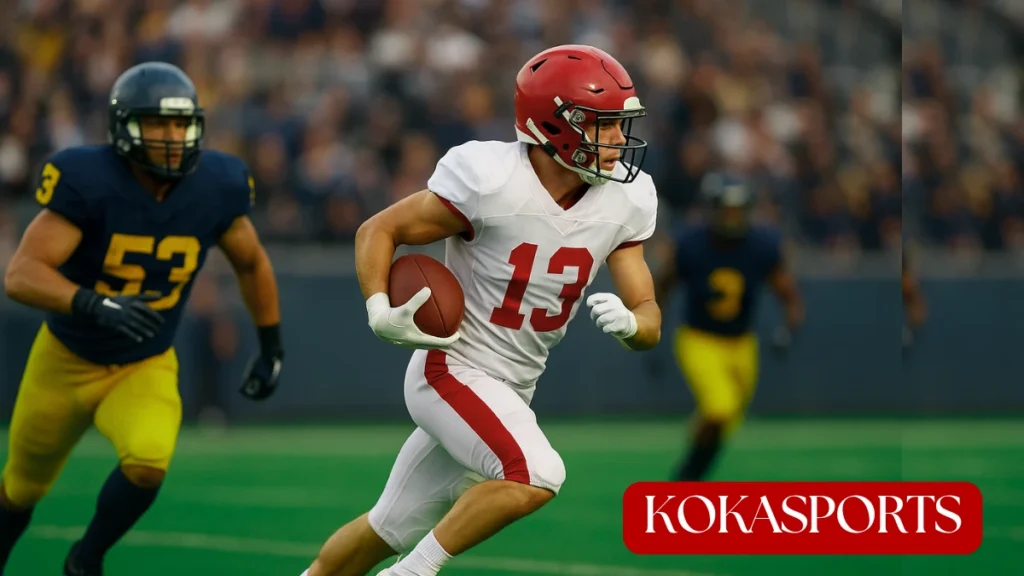
Complete Route Tree Breakdown
The traditional football route tree provides the foundation for understanding how wheel routes fit into broader passing concepts. Most playbooks organize routes using a numbering system where each number corresponds to a specific route pattern, with the wheel route typically designated as route number 6 or 7.
Understanding the route tree helps players, coaches, and fans appreciate why certain route combinations work effectively together. The wheel route occupies a unique position because it combines elements of both horizontal routes (like the flat route) and vertical routes, making it effective against different routes and coverage schemes.
Standard Route Tree:
| Number | Route | Direction | Primary Use |
|---|---|---|---|
| 1 | Slant route | Inside diagonal | Quick timing vs man coverage |
| 2 | Flat route | Horizontal | Check down, low-percentage but safe |
| 3 | Comeback | Back toward quarterback | Zone coverage attack |
| 6/7 | Wheel route | Flat then turn upfield | Mismatch creation |
| 8 | Post route | Inside deep | Middle of the field attack |
| 9 | Go route | Vertical | Deep threat |
The wheel route‘s hybrid nature makes it particularly effective at creating coverage confusion. Unlike pure horizontal or vertical routes, the wheel changes direction during execution, which disrupts defender expectations and creates separation opportunities.
Defending Against Wheel Routes
As wheel route usage has increased, defensive coordinators have developed specific strategies to limit their effectiveness. Understanding these counters helps explain why wheel routes work in some situations but fail in others.
Man coverage adjustments often involve switching coverage responsibilities or using bracket techniques. When a linebacker recognizes wheel route development, he may call for safety help or attempt to pass the receiver off to a defensive back better equipped to handle the downfield portion.
Zone coverage adjustments focus on communication and pattern recognition. Defenders learn to identify wheel route stems early and adjust their responsibilities. This often involves underneath defenders expanding their zones while safety help rotates toward the wheel threat.
Defensive counters include:
- Bracket coverage: Two defenders sharing wheel route responsibility
- Pattern recognition: Early identification by covering the receiver
- Communication: Defenders alerting teammates to threats
- Physical disruption: Legal contact to disrupt timing
- Blitz packages: Forcing quick decisions before routes develop
However, these adjustments carry risks. Blitz packages can create even better opportunities for wheel route success if pressure doesn’t reach the quarterback quickly enough, leaving open space for the receiver running the pattern.

Conclusion
The wheel route remains one of football’s most versatile and effective pass concepts, serving as a critical component in playbooks across all levels of the game. From youth football basics to complex NFL implementations, this route continues to challenge defenders and create explosive offensive opportunities.
Understanding the wheel route helps players execute better technique, coaches design more effective concepts, and fans appreciate the strategic complexity of modern football. Whether used as a simple base play or part of sophisticated route combinations, the wheel route demonstrates why fundamental concepts remain relevant even as the game evolves.
The route’s effectiveness stems from its ability to create mismatches, exploit coverage weaknesses, and provide quarterbacks with reliable options in various game situations. As offensive systems continue evolving, the wheel route will undoubtedly adapt while maintaining its core identity as a coverage-beating concept.
For players looking to master this route, focus on selling the initial flat movement before making a decisive turn upfield. The wheel route rewards patience, precision, and explosive acceleration – qualities that translate to success in all areas of the field. Whether you’re running the wheel in competitive flag football or studying NFL concepts, this fundamental route deserves a place in every serious football student’s understanding.
FAQs
What is the hardest route in football?
The post route is the hardest because receivers run through heavy traffic and risk big hits from defenders.
How many yards is a wheel route?
A wheel route covers 8-20 yards total – about 5 yards toward the sideline, then turning upfield.
What is the difference between a hook route and a curl route?
Hook route: receiver stops and faces the quarterback. Curl route: receiver makes a smooth turn back.
What is a post wheel route?
A post wheel route starts like a post route toward the middle, then breaks to the sideline and turns upfield.

